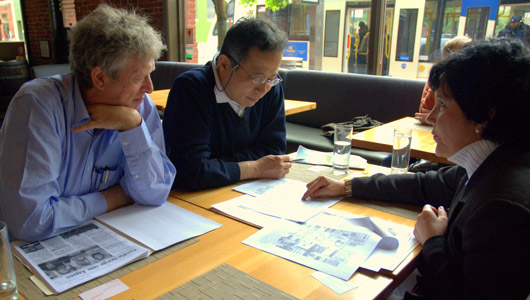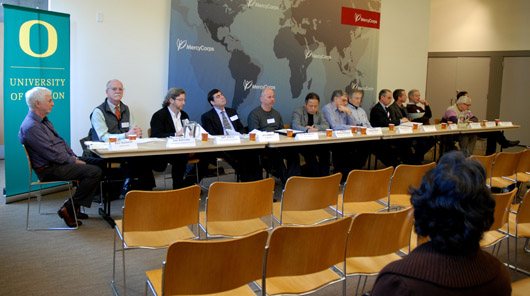By Sabina Samiee
In the fall of 2010, Professor Hajo Neis of the Department of Architecture in Portland began a sabbatical stay in Tokyo. Neis initiated a collaborative relationship with Toyko’s Meiji University and faculty member, Professor Masami Kobayashi from Meiji University’s Department of Architecture in the School of Science and Technology. Kobayashi was Neis’ coordinating professor for his visit. The exchange proved to be a fruitful one with both professors discussing forms of possible collaboration that would incorporate student and faculty cooperation, as well as design, research and creative professional projects that would involve a close collaborative relationship between UO Department of Architecture program in Portland and Meiji University. After his visit to Tokyo, Professor Neis invited Professor Kobayashi to come to Portland and deliver a lecture to Oregon audiences on the urban development of Tokyo from the Edo-Period.
Only a few weeks before his planned visit to Portland, Japan experienced the devastating March 2011 Tohoku Region earthquake. The disaster was threefold—earthquake, tsunami, and nuclear fallout. Despite these challenges, Kobayashi, travelled to Portland and instead of giving one lecture on urban development, incorporated a second lecture explaining the massive destruction of the earthquake. Hajo Neis, recalls this lecture as “one of the most memorable lectures [he has] ever heard.” Kobayashi had visited the disaster area and wanted to bring a complete report to his Portland audience. While he was speaking, despite tears streaming down his cheeks, Kobayashi described the devastation, the people, and the catastrophe with an emotionally restrained calm. The audience remained completely silent captivated by Kobayashi’s detailed account of Japan’s situation.
It was Kobayashi’s lecture on the earthquake ravaged landscape of Tohoku that prompted Neis to begin his thesis studio, Regenerative Design. Regenerative Design gave architecture students an opportunity to work to craft rebuilding concepts for both the Tohoku disaster area in Japan and other disaster areas in the world.
Now, a year later, Kobayashi has returned to Portland to give a third lecture on the “Reconstruction Efforts for Japan’s Earthquake Disaster.” He delivered “Reconstruction Efforts” on March 9, 2012 at Mercy Corps world headquarters in Portland. His visit also coincided with his review and critique of the UO architecture students’ work in Neis’ Regenerative Design studio. As Neis comments, due to Kobayashi’s recent experience with the Tohoku earthquake recovery efforts, he served as “an invaluable and knowledgeable critic” of the students’ work. As part of the on-going collaboration with Meiji University, Professor Neis will incorporate Meiji University’s continued involvement with the Regenerative Design studio.
An added component of Professor Kobayashi’s visit to Portland, has been his recent collaboration with the potential redevelopment of Old Town | Chinatown. In the summer of 2011, Kobayashi had visited Portland and met with Anne Naito-Campbell, a business and community development consultant and lifetime resident of Portland. Naito-Campbell (daughter of real estate mogul Bill Naito) who has family connections to Japan had been interested in the addition of a Japan-gate to the Old Town region.

Historically, the background of Old Town | Chinatown is also the history of Portland’s Japantown. In the 1890s, hundreds of young Japanese immigrants arrived in Oregon to work on railroads, lumber mills, farms and fish canneries. Portland’s region by the Willamette River north of West Burnside Street became known as Japantown or Nihonmachi. By 1940, there was a thriving Japanese cultural area in this location all within a 6-8 block area. By 1942, Japantown had disappeared completely when all persons of Japanese ancestry were removed from the West Coast and placed into concentration camps due to World War II anti-Japan sentiment.
Anne Naito-Campbell’s interest in reviving Japantown and the region’s sense of Asian heritage stems from her family’s connection to Portland and Japan. With family background originating from a Japanese ancestry; Naito-Campbell’s father held the dream of bringing a Japan-gate to the area. Her father had been actively involved in bringing the existing China Gate to Portland in the 1980s, and helped plant the 100 Japanese Cherry Trees planted on the Waterfront, in addition to being involved in building the Japanese American Historical Plaza in north Waterfront Park.
Neis who had invited Naito-Campbell to attend Kobayashi’s original Portland lectures on urban development and the post-earthquake redevelopment, had subsequently encouraged Naito-Campbell to be involved in the Meiji-UO liaison by integrating her with an international joint comprehensive development study of Old Town | Chinatown. Neis continued to foster this collaboration by introducing Naito-Campbell to UO Department of Architecture Professor Howard Davis. Professor Davis was working with both Neis and Kobayashi by teaching one of the three graduate design studios focusing on ideas for redevelopment for Old Town | Chinatown and Japan’s earthquake rebuilding.
When Kobayashi returned to visit to Portland in the summer of 2011, he was well established in dialogue with Naito-Campbell for the design of a Japan gate for Old Town. As a direct result, Kobayashi started a design studio with his third year Meiji students in the fall of 2011 to design and prototype projects from a purely Japanese perspective. These nine Meiji University students travelled to Portland in March 2012 to present their projects to Old Town | Chinatown and UO. Neis describes the Meiji students’ proposals as showing “fresh ideas and new pedestrian life for the area.” Professor Howard Davis commented on the Meiji student work saying “I was particularly impressed with the design work that [Kobayashi’s] students had done for the area. It was very imaginative, and the discussion about it raised lots of issues that we’ll consider in the fall, when we do more design work.”

In a display of cross-community collaboration, Kobayashi’s visit and the work of Neis and Davis with their UO studio courses, ultimately contributed to the bringing together of community leaders for the Old Town | Chinatown region. This weaving together of the culturally significant tapestry that is Old Town has culminated in a more open communication between developers, historians and residents of the Old Town area. At Mercy Corps world headquarters in Portland, on March 9, as a part of Kobayashi’s Portland visit along with the nine Meiji University students he brought with him, community stakeholders (key developers, architects, city officials), joined Professor Davis and Kobayashi to participate in a panel discussion addressing how the Old Town neighborhood has changed over the last ten years and how the area can continue to positively evolve while embracing its cultural heritage. Organized by Naito-Campbell with support from Mercy Corps, the panel addressed how redevelopment of the area is crucial while retaining the intention to not eclipse the diverse cultural past. Panelists also discussed the somewhat difficult reputation of the area, and the development restrictions due to the area’s historic status.

Students in Neis’ and Davis’ studio courses will continue to study and explore in-depth possibilities for the community carefully noting use, condition, height, history, street-level activity of each proposed building. Davis’ students publically presented their concepts in a final review session at the White Stag Block on March 21.
Future collaboration plans between Neis, Davis, and Kobayashi will develop into the fall of 2012. The intention to begin three design studios (two at UO in Portland, one at Meiji University in Tokyo) for Old Town based on Professor Davis’ research and seminar will continue. The professors also hope to initiate a small advisory group based on the panel group discussion and to move forward with the ideas and dialogue presented there. The architecture students in these studio programs, both in Portland and at Tokyo’s Meiji University will carry on in the collaboration by further analyzing several Old Town development possibilities, including pressing forward with the plans for a Japan gate. As Davis commented during the panel discussion “[these] will be hypothetical projects, but looking at them could help move the conversation….forward….”
This community and cultural collaboration was enhanced by the participation of Anne Naito-Campbell. As professor Davis says, this “ collaboration between two UO studios and one of Professor Kobayashi’s graduate studios at Meiji University. ….is a great opportunity, and we’re very fortunate to have [Kobayashi’s] support and the support of Anne Naito-Campbell and other people in the community and city.”
Following his return to Japan in March 2012, I contacted Professor Kobayashi and asked if he could respond to his experience here in Portland. Reproduced, here, in full is his reply:
Thoughts on Academic Collaboration and the Real Field we have to tackle on.
By Masami Kobayashi
The world is coming smaller and smaller with the progress of communication media such as Internet and Twitters.
Furthermore, we need to think beyond our boundary about the environmental issues such as global warming and Disaster issues such as earthquake and Tsunami, and hence to share our ideas to solve these issues.In that sense, our visit to the School of Architecture and Allied Arts, University of Oregon in Portland, bringing our 3rd year young students of Meiji University looked very effective and our students seemed to have learned a lot from the faculties and the students of UO during our short stay. Though the timing was not so good before the deadlines in UO, the both students seemed to feel something important from each other’s works.Our project dealt with the revitalization vision of the old historic district surrounding the UO Portland campus building, and our students proposed a rough urban design schemes and architectural proposals based on their urban studies. In the public symposium at Mercy Corps on March 9th, the local stakeholders, city officials, academic people, and people from historic institutions sat together as the panelist, and discussed on the coming future of the district. I felt something important has just started for the district, and the design works by both of the students, which were displayed on the surrounding walls of the symposium, looked helpful to evoke and activate the debate of the symposium.We teachers always have to think how to balance the education of our students between the traditional theoretical studies and the practical experiences which is connected to the real society, and we also need to think how the universities can support the local community to enhance its own culture which empowers its local identity. Thus, our experimental visit to UO and Mercy Corps might be a kind of catalysis to let the students to think that balance and let the local people be conscious about the future of the district. I thank to all of the related people for giving us such fantastic experiences.
[The author of this post extends her sincere appreciation to Hajo Neis, Masami Kobayashi, Howard Davis, and Anne Naito-Campbell for their input and cooperation on this article, thank you. -SS]
One comment on “University of Oregon Collaborates with Tokyo’s Meiji University | Architecture Studios Focus on Regeneration and Redevelopment”